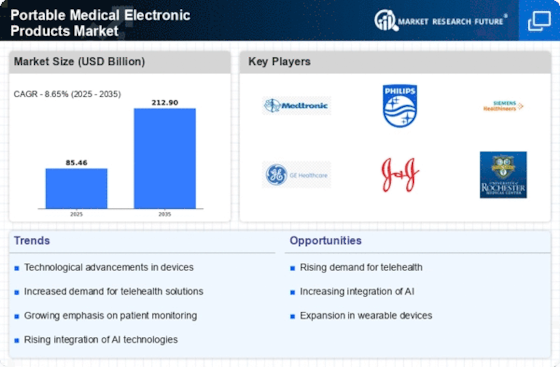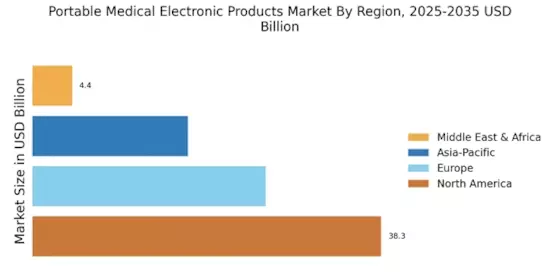Supportive Regulatory Environment
A supportive regulatory environment is crucial for the growth of the Portable Medical Electronic Products Market. Regulatory bodies are increasingly recognizing the importance of portable medical devices in enhancing patient care and are streamlining approval processes for innovative products. This regulatory support fosters an environment conducive to research and development, encouraging manufacturers to invest in new technologies. For instance, the FDA has introduced initiatives to expedite the review of breakthrough devices, which can significantly shorten the time to market. As a result, the Portable Medical Electronic Products Market is likely to witness an influx of innovative products that meet regulatory standards, ultimately benefiting consumers and healthcare providers alike.
Rising Awareness of Preventive Healthcare
The Portable Medical Electronic Products Market is benefiting from a rising awareness of preventive healthcare among consumers. As individuals become more health-conscious, there is a growing emphasis on early detection and management of health issues. Portable medical devices, such as fitness trackers and health monitoring systems, empower users to take charge of their health by providing real-time data and insights. This trend is reflected in the increasing sales of wearable health technology, which is projected to reach USD 60 billion by 2025. The focus on preventive healthcare not only enhances individual well-being but also reduces long-term healthcare costs, thereby driving the demand for portable medical products. As a result, the Portable Medical Electronic Products Market is likely to see continued growth as consumers prioritize proactive health management.
Technological Advancements in Medical Devices
Technological advancements are playing a pivotal role in shaping the Portable Medical Electronic Products Market. Innovations in sensor technology, connectivity, and miniaturization have led to the development of more sophisticated and user-friendly medical devices. For instance, the integration of Bluetooth and Wi-Fi capabilities allows for seamless data transfer between devices and healthcare providers. This connectivity enhances remote monitoring and telehealth services, which are increasingly favored by both patients and healthcare professionals. The market for portable medical devices is expected to grow at a compound annual growth rate of 10% over the next five years, driven by these technological innovations. Consequently, the Portable Medical Electronic Products Market is poised for substantial growth as it adapts to the evolving technological landscape.
Increasing Demand for Home Healthcare Solutions
The Portable Medical Electronic Products Market is experiencing a notable surge in demand for home healthcare solutions. This trend is driven by an aging population and a growing preference for at-home medical care. According to recent data, the home healthcare market is projected to reach USD 300 billion by 2026, indicating a robust growth trajectory. Portable medical devices, such as blood pressure monitors and glucose meters, are becoming essential tools for patients managing chronic conditions at home. This shift towards home-based care not only enhances patient comfort but also reduces the burden on healthcare facilities. As a result, the Portable Medical Electronic Products Market is likely to expand significantly, catering to the needs of patients seeking convenient and effective healthcare solutions in their own environments.
Growing Investment in Health Technology Startups
The Portable Medical Electronic Products Market is witnessing a surge in investment in health technology startups. Venture capital funding for health tech has increased dramatically, with investments reaching over USD 20 billion in the past year alone. This influx of capital is driving innovation and the development of new portable medical devices that cater to diverse healthcare needs. Startups are focusing on creating user-friendly, cost-effective solutions that enhance patient engagement and improve health outcomes. As these new entrants disrupt traditional healthcare models, the Portable Medical Electronic Products Market is expected to evolve rapidly, offering consumers a wider array of options for managing their health effectively.


















Leave a Comment